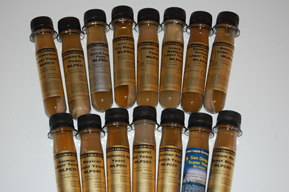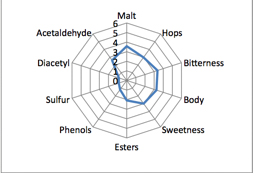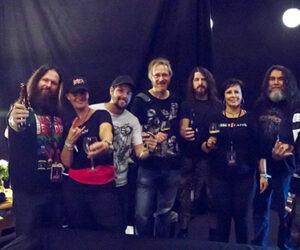Operation Strain
I have been a member of the Keg Ran Out Club (KROC) in Broomfield, Colorado for about eight years, and during that time I’ve seen my batch size increase five-fold, to 25 gallons (95 L) post boil. One day while homebrewing it occurred to me that I could work with my homebrew club at that volume to try some parallel experiments. I decided that supplying 10 people with 2 gallons (7.6 L) each of wort would be a nice group size to work with. Being a post-boil split, a yeast experiment was a prime candidate: At that volume a single vial of yeast would supply about the perfect pitch rate without requiring a yeast starter, and variations in experimental parameters could be fairly easily controlled or eliminated. I’d been focusing on brewing German Pilsner at the time, and was experimenting with a few different yeast strains. I thought that a group experiment like this would be great for sharing the work to be done in finding the perfect strain.
We did our yeast project shortly after our Great American Beer Challenge homebrew competition, hosted annually at Arvada Beer Company by owners and award-winning brewers Cary and Kelly Floyd, who are also long-standing KROC members and huge supporters of the club. They volunteered to let us brew in their brewhouse with their pilot system kettle, a 55-gallon (208-L) Boilermaker, which would allow us to double the participant slots available.
We recruited 12 homebrewers from the club willing to do 16 different batches. Each requested or was assigned a strain within their temperature control ability. White Labs provided vials of the requested strains, all freshly packaged about a week earlier.
Methodology
On brew day we did two parallel mashes using my two 27-gallon (102-L) stainless kettles. We targeted and achieved a low mash temperature of 150 °F (66 °C), which was intended to enhance fermentability and accentuate the differences in attenuation among strains. Our grain bill was entirely Pils malt, and I treated the liquor with gypsum and calcium chloride to promote the hop bitterness and to provide sufficient calcium for healthy fermentation. After a mash-out infusion and some recirculation we proceeded to sparge and lauter, collecting 41 gallons (155 L) of hot sweet liquor. We began the 90-minute boil with a 40-IBU charge of Magnum hops for bitterness and in the last few minutes we added two pounds of Noble hops: A mix of Hallertau Hersbrucker and Spalt. After a quick gravity check (1.046 S.G.) we whirlpooled for 20 minutes, then counterflow chilled the wort to 55 °F (13 °C), infused with inline oxygen, and drained into 16 carboys. Each brewer then headed home to stash the wort under temperature control until it reached the assigned fermentation temperature (see the recipe below).
Each brewer was assigned an optimum fermentation temperature for his or her strain, generally 52 °F (11 °C) for lager yeasts and 68 °F (20 °C) for ale. They were instructed to chill the wort to their respective temperature and then shake the carboy vigorously for two minutes. After aeration they were to sanitize the yeast vial, agitate and pitch, then leave the carboy alone until fermentation signs subsided. Once activity slowed, each brewer brought their batch(es) up to a diacetyl rest for two days at several degrees above fermentation temperature, then chilled slowly back to fermentation temperature until they were ready to bottle. Each batch of wort came with a measured dose of bottling sugar for the 2-gallon (7.6-L) batch. All brews were bottled within a few day span, bottle conditioned for at least a week, then chilled. Total time from brew day until the meeting was 28 days, quick for the lagers, but aided by the relatively high pitch rate and initial oxygen levels.
At the club meeting, I randomly assigned members into three sampling groups. Each judge received a form with spots for 16 beers, on which to rate each on a 0–10 scale based on eight different attributes: Malt intensity, hop intensity, bitterness, body, sweetness, esters, phenols, sulfur, diacetyl and acetaldehyde. The samples were presented with a blind judging number, and the presentation order varied among the sample groups. The first two samples for each group were the “classic” German Lager and Southern German Lager strains, which were intended to establish a baseline. Each group completed quick evaluations of all 16 beers in approximately 20–25 minutes, which I collected for some number crunching and analysis.
I had my work cut out for me. I wanted to produce spider plots based on the average ratings, but found that my data was widely varied. Some people rated every attribute between 0 and 3, while others had attributes such as diacetyl or phenols in the 4–8 range across each beer — apparently my samplers had done some “sampling” of their own at the meeting prior to the experimental tasting. I decided to leave the personal ranges unmodified, which seemed justified based on the graphs produced, and applied a few techniques to crunch the data, mainly weighting each group based on sample order (being a bitter and hoppy beer it affected taste thresholds considerably over the course of several samples).
I then enlisted the aid of Greg Toothaker and John Allison, BJCP National Judges; Don Blake and David Lytton, Masters; and also sat in myself (BJCP Grand Master). We gathered about a month after the tasting at the club meeting and utilized a “best of show” type setup where each of the samples was presented side by side. Strain names were provided. The beers had had a bit more time to mature and cold-age, and some flavor changes were noted. Having frequently worked together before, we quickly determined a consensus opinion for each beer, noting the high and low points and how well it fit the German Pils style. After discussion we started eliminating beers until we had a few standouts, then rank-ordered the remaining beers until we had our “best of show (BOS.)”
In the data that follows, I’ve gatherd the distilled notes provided by the experienced judging panel. The assigned fermentation temperature, measured terminal gravity, and the rank in the “German Pils BOS” are also shown. One strain (San Francisco Lager) was assigned at both 58 and 65 °F (14 and 18 °C). The Cry Havoc strain was also done at 65 °F (18 °C) by the same brewer as the high-temperature SF Lager; unfortunately both of these batches suffered a strong light-strike flavor and aroma defect and were not included in the final results. I also created a spider plot graph for each strain from the quantitative sampling at the club meeting, which you can see below.
Mexican Lager – WLP940
Temp: 52 °F (11 °C) F.G.: 1.006
BOS Rank: 1
The Mexican Lager strain was the favorite of the judges. It presented as very clean, with a strong but pleasant bitter character and a crisp finish. The hop flavor also came through best with this strain when compared side-by-side with others.
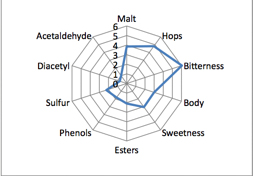
German Lager – WLP830
Temp: 52 °F (11 °C) F.G.: 1.010
BOS Rank: 2
This was the first beer presented at the quantitative evaluation session. The judges found it to be very true to style, but less crisp and with a sharper bitterness than other samples. Hop character came through well, but carried some astringency not found in the other samples.
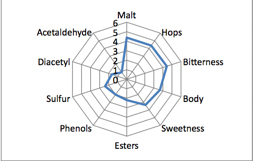
Southern German Lager – WLP838
Temp: 52 °F (11 °C) F.G.: 1.008
BOS Rank: 3
The judges found this to be more malt forward than WLP830, providing a better balance with the hops. The bitterness was not harsh or astringent, and the finish was crisper. Some esters were noted, along with a light “yeasty” character. This was the favorite when re-tasted with the brewers at Arvada Beer Company.
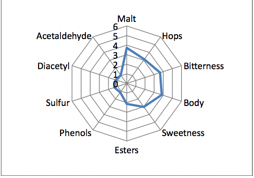
American Lager – WLP840
Temp: 52 °F (11 °C) F.G.: 1.003
BOS Rank: 4
A definite alcohol note was detected by the judges in this sample, and acetaldehyde/green apple was also present, though it wasn’t noted at the earlier tasting. The malt presented as more toasty than in other samples, and the bitterness lingered longer.

San Francisco Lager – WLP810
Temp: 58 °F (14 °C) F.G.: 1.010
BOS Rank: 5
The judges found this to be reasonably close to the classic German strains. Very light diacetyl and acetaldehyde were detected, as well as a slightly higher level of esters than the classics. The malt presented as very mild, and the finish was not as crisp.
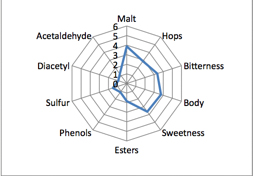
German Bock Lager – WLP833
Temp: 52 °F (11 °C) F.G.: 1.010
BOS Rank: 6
The Bock strain seemed to greatly mute the hop intensity and bitterness, and therefore was judged to be very malt forward. There was also a bit of diacetyl reminiscent of butterscotch or caramel, and the finish was noted as sweeter and less crisp than the more traditional Pilsner strains.

Pilsner Lager – WLP800
Temp: 52 °F (11 °C) F.G.: 1.010
BOS Rank: 7
Our second Czech strain produced an overall mild beer that exhibited a lower level of malt and bitterness than the classic German strains. The malt presented a grainy, bready character. There was a low level of corn-like, almost vegetal, DMS. The beer was noted as particularly clear in appearance compared to the others.
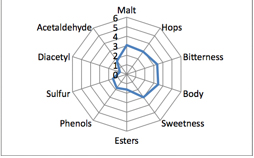
Czech Budejovice Lager – WLP802
Temp: 52 °F (11 °C) F.G.: 1.005
BOS Rank: 8
The judges found fairly strong diacetyl as the main detraction for this strain, and also some acetaldehyde as the samples warmed. The diacetyl was not as noticeable in the earlier tasting. The bitterness was lower and smoother than the classic German strains, the color was also noted as darker, and the perceived finish sweeter.
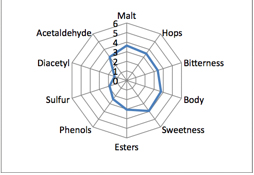
German Ale/Kölsch – WLP029
Temp: 68 °F (20 °C) F.G.: 1.006
BOS Rank: 9
The judges found this beer to lack the traditional light ester profile of a Kölsch, which kept it in line with the German Pils style. Malt was soft and subdued, with a yeasty/bready character. Light acetaldehyde was noted, as well as low sulfur and some acidity. The hop flavor was light, and bitterness lingered well into the aftertaste.
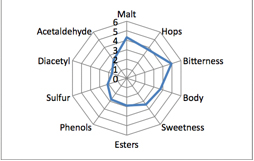
San Diego Super Yeast – WLP090
Temp: 68 °F (20 °C) F.G.: 1.009
BOS Rank: 10
A light butterscotch-like aroma was noted, as well as some sulfur. The bitterness seemed to be intensified almost to the point of harshness, while the hop flavor and aroma were subdued in comparison to other strains.
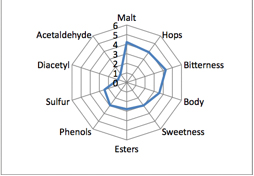
Cream Ale Blend – WLP080
Temp: 68 °F (20 °C) F.G.: 1.004
BOS Rank: 11
The judges found this to be quite clean, with only very low esters. Judges noted it as smooth and creamy, but lacking any character from the Pils malt. The finish was perceived as somewhat sweet despite the low final gravity. Hop flavor, aroma, and bitterness were quite subdued.
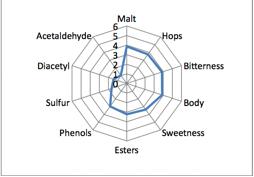
California Ale – WLP001
Temp: 68 °F (20 °C) F.G.: 1.009
BOS Rank: 12
This strain presented with some clove-like phenols and moderate esters. The bitterness was long lasting and somewhat harsh. The body was relatively thick, and lacked the crispness associated with the style. Not a good substitute for a clean lager yeast.
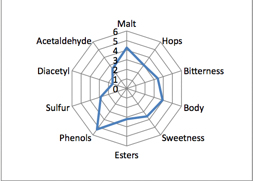
Zurich Lager – WLP885
Temp: 52 °F (11 °C) F.G.: 1.005
BOS Rank: 13
This strain produced a beer that was definitely not in style for a German Pils. A moderate spicy phenol was present in both aroma and flavor, though it fell short of more Belgian style qualities due to a lack of esters. The malt character was noted as particularly toasty.
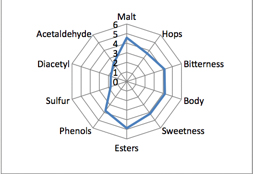
Trappist Ale – WLP500
Temp: 68 °F (20 °C) F.G.: 1.006
BOS Rank: 14
This yeast exhibited a more traditional Belgian profile with clove and vanilla phenols, and esters of banana and bubblegum. Hops and malt were both low, and the bitterness did not linger into the finish. There was a perception of alcohol in the aroma and flavor. The beer was quite tasty, but certainly not a German Pils.
Conclusions
The experiment definitely demonstrated the huge impact that yeast strain has on the finished beer. Everything from intensity, character, and balance of the malt and hops, to the color of the beer is subtly or strongly influenced by the yeast.
Of particular note:
The Bock strain’s ability to make malty bock-like beer even from hoppy wort. The Trappist and Cream Ale strains showed similar effects for their respective styles.
The Czech strain’s diacetyl production, which tracks with the acceptability of low levels in the Bohemian style Pilsener.
The Mexican and American strains’ overall profiles point to potential German origin, consistent with the influx of German brewers into Mexico and the United States during the late 1800s.
The San Diego Super Yeast’s ability to emphasize bitterness but reduce hop flavor and aroma.
Final gravity readings varied from 1.003 to 1.015 S.G.
None of the ale strains were able to produce a convincing lager.
A month of lagering in the bottle between judging sessions served to change the profile to varying degrees. Some beers that were high in diacetyl or acetaldehyde were much more pleasant after aging, though some were found to have changed for the worse.
I’d like to thank the brewers of the Keg Ran Out Club for participating, as well as John Carroll and White Labs, my all-star BJCP judge team, and Cary and Kelly Floyd of Arvada Beer Company for supporting this enlightening experiment.
KROC Yeast Experiment Recipe
KROC German Pils
(5 gallons/19 L, all-grain)
OG = 1.046 FG = 1.003-1.015
(strain dependent)
IBU = 50 SRM = 3 ABV = 4.1-5.7% (strain dependent)
Ingredients
9.5 lbs. (4.3 kg) continental Pilsner malt (2 °L)
9.6 AAU Magnum pellet hops (90 min.)
(1 oz./28 g at 9.6% alpha acids)
6.8 AAU Hersbrucker pellet hops
(5–0 min.) (2.25 oz./64 g at 3% alpha acids)
10.8 AAU Spalt pellet hops (5-0 min.)
(2.25 oz./64 g at 4.8% alpha acids)
Yeast strain of choice
Priming sugar (if bottling)
Step by Step
We pre-treated our strike water with 0.9 grams/gallon gypsum and 0.6 grams/gallon calcium chloride to promote a healthy fermentation and hop bitterness. Heat 3.5 gallons (13 L) to achieve a stable mash temperature at 150 °F (66 °C). Hold at this temperature until starch conversion is complete. Sparge with 170 °F (77 °C) water, collecting wort until the pre-boil kettle volume is around 6.5 gallons (25 L).
The total wort boil time is 90 minutes adding the Magnum hops at the very beginning of the boil. Mix all the Spalt and Hersbrucker hops together and start to add slowly with 5 minutes remaining in the boil. Space the addition out over the final 5 minutes.
Whirlpool the wort for 20 minutes then chill the wort to desired fermentation temperature and aerate thoroughly. Pitch the yeast of your choice and ferment at recommended temperature, about 52 °F (11 °C) for bottom fermenting yeast and 68 °F (20 °C) for top fermenting yeast. If using a bottom fermenting yeast, once active fermentation is complete, bring the beer up to diacetyl rest for two days, then slowly chill back to lagering temperature. After proper lagering time (about one month), rack to a keg and force carbonate or rack to a bottling bucket, add priming sugar, and bottle. Target a carbonation level of 2 to 2.5 volumes.
KROC German Pils
(5 gallons/19 L, extract only)
OG = 1.046 FG = 1.003-1.015
(strain dependent)
IBU = 50 SRM = 4 ABV = 4.1-5.7% (strain dependent)
Ingredients
5.1 lbs. (2.3 kg) Pilsen dried malt extract (2 °L)
10.6 AAU Magnum pellet hops (60 min.) (1.1 oz./31 g at 9.6% alpha acids)
6.8 AAU Hersbrucker pellet hops (5–0 min.) (2.25 oz./64 g at 3% alpha acids)
10.8 AAU Spalt pellet hops (5–0 min.) (2.25 oz./64 g at 4.8% alpha acids)
Yeast strain of choice
Priming sugar (if bottling)
Step by Step
We pre-treat our strike water with 0.9 grams/gallon gypsum and 0.6 grams/gallon calcium chloride to promote a healthy fermentation and hop bitterness. Bring 6 gallons (23 L) of water up to a boil. Remove from heat and add dried malt extract. Bring back to a boil. The total wort boil time is 60 minutes adding the Magnum hops at the very beginning of the boil. Mix all the Spalt and Hersbrucker hops together and start to add slowly with 5 minutes remaining in the boil. Space the addition out over the final 5 minutes.
Whirlpool the wort for 20 minutes then quickly chill the wort to desired fermentation temperature and aerate thoroughly. Pitch the yeast of your choice and ferment at recommended temperature, about 52 °F (11 °C) for bottom fermenting yeast and 68 °F (20 °C) for top fermenting yeast. If using a bottom fermenting yeast, once active fermentation is complete, bring the beer up to diacetyl rest for two days, then slowly chill back to lagering temperature. Now follow the remainder of the all-grain recipe (above).


